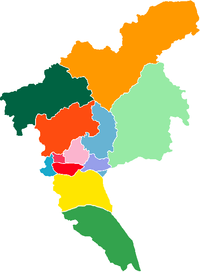Guangzhou Higher Education Mega Center
Guangzhou Higher Education Mega Center (HEMC), Guangzhou University Town or Guangzhou University City (Chinese: 广州大学城) is an area featured by higher education institutions, located on Xiaoguwei Island (Chinese: 小谷围岛) in Panyu District, Guangzhou, China. It was opened in 2004. With an area of approximately 17.9 km2 and 3.53 millions square meters of indoor space, the complex is capable of accommodating 350 to 400 thousand people.[1]
| Guangzhou Higher Education Mega Center | |||||||||||
|---|---|---|---|---|---|---|---|---|---|---|---|
| Traditional Chinese | 廣州大學城 | ||||||||||
| Simplified Chinese | 广州大学城 | ||||||||||
| |||||||||||
Components
In phase I of the project, ten local higher education institutions set up new campuses on the Xiaoguwei island with a total capacity of 120,000 students. All except Guangzhou University maintain their old campuses within the city.
Besides ten universities, Guangdong Science Center (Chinese: 广东科学中心), a major science center in China, is located in the Higher Education Mega Center on the west end of Xiaoguwei island.
In the phase II, two more universities set up campuses in Xinzao town which is located across the river on a separate site. The twelve institutions are:[2]
| Phase | University | Chinese | Est. | Type | Location |
|---|---|---|---|---|---|
| Phase I | Sun Yat-sen University | 中山大学 | 1924 | National | Xiaoguwei Island |
| South China University of Technology | 华南理工大学 | 1952 | National | ||
| South China Normal University | 华南师范大学 | 1933 | Provincial | ||
| Guangdong University of Foreign Studies | 广东外语外贸大学 | 1995 | National | ||
| Guangdong University of Technology | 广东工业大学 | 1995 | Provincial | ||
| Guangzhou University | 广州大学 | 2000 | Provincial | ||
| Guangzhou University of Chinese Medicine | 广州中医葯大学 | 1956 | National | ||
| Guangdong Pharmaceutical University | 广东药学院 | 1958 | Provincial | ||
| Xinghai Conservatory of Music | 星海音乐学院 | 1932 | Provincial | ||
| Guangzhou Academy of Fine Arts | 广州美术学院 | 1953 | Provincial | ||
| Phase II | Jinan University | 暨南大学 | 1906 | National | Xinzao town |
| Guangzhou Medical University | 广州医科大学 | 1958 | Provincial | ||
| South China University of Technology International Campus | 华南理工大学广州国际校区 | 1952 | National | ||
Transportation
The island can be accessed through the toll Nansha Port Expressway, which links the island to Haizhu District to the north and Panyu District to the south. A two-section cross-river tunnel provides alternative free of charge access to the island, linking it to the Luntou (Chinese: 仑头) area in Haizhu District via the planned Biological Industry Island (Chinese: 广州国际生物岛). In addition, a bridge connects the island to the southeast part of Haizhu district near the Yingzhou Ecological Park.
Two Guangzhou Metro stations are located on the island. The Higher Education Mega Center North Station (Chinese: 大学城北站) and South Station (Chinese: 大学城南站) of Line 4 provide access to Guangzhou's metro network.
The island is served by a dozen of bus routes, with buses running mainly between the university town and the city centre. Generally there are two types of bus service: Regular buses operating like buses within the city centre, make frequent stops and therefore the trip takes longer; whilst express buses dedicated to serve the university town, mainly run on expressways and makes less stops. Many of these express buses travel between the old and new campuses of the universities. There are also shuttle buses provided by some universities which travel between their own campuses. However, these buses are reserved for the university faculty and staff and can not be used by the public or students. Inside the university town, students and teachers usually walk or cycle to classes, or ride a bus to farther locations like other universities and the shopping malls. The most heavily used bus route is 381, which runs along the middle ring road that connects all ten universities and two metro stations together.
Sporting facilities
All ten universities built their own sports facilities as part of the campus development, while some shared facilities were constructed by the government. They include the 39,000-capacity Guangzhou Higher Education Mega Centre Central Stadium, which is used mostly for football, and other venues for the 2010 Asian Games.
References
- Guangzhou Higher Education Mega Center
- "Guangzhou Higher Education Mega Center". Archived from the original on 2012-05-15. Retrieved 2008-12-17.

